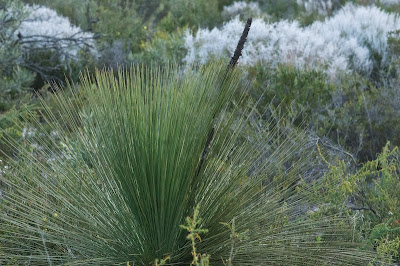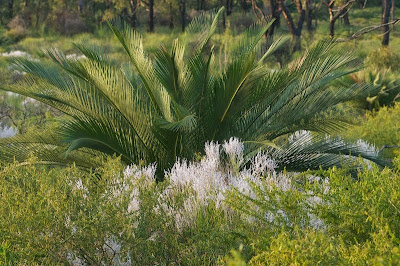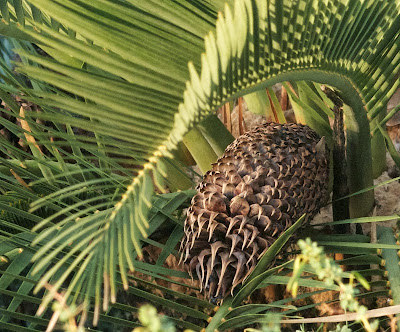It's taken four entries, of which this is the last, just to give a taste of Lesueur National Park, one of the richest wildflower spots in the world, and specifically our scenic drive around it on the afternoon of September 15, 2013.
Just to review: Lesueur is not a large park, but it is an exceptionally diverse one with over 900 species of flowering plants. Most of it is covered by a type of sandy heathland known as Kwongan, and the best way to see that in a hurry is to follow the Lesueur Scenic Drive, a one-way track that takes you around the flat-topped mesa that gives the park its name.
We were, quite literally, up to our ears in flowers. My way of trying to get a handle on all this floral richness in a short period of time was to photograph every flowering plant that I could see, and hope that I could figure out the identifications later. This worked, more or less, much of the time, at least to genus level, but actual botanists will have to take my specific identifications with a grain of salt.
I have probably posted too many photographs of Cat's Paw (Anigozanthos humilis) already, but it is such a fascinatingly colourful little plant (and so typical of the Australian southwest) that I cannot resist adding a few more.
Only a few flowers are open at the end of this raceme, but the inflorescence is no less attractive for that.
In my first three Lesueur posts I profiled three of its preeminent plant families, Haemadoraceae, Proteaceae and Myrtaceae. Here, in my last post, I can always claim that I am posting more of each for review (no, there won't be a quiz). Cat's Paws, and these coneflowers (Conostylis sp), belong to the Haemadoraceae, so starting off with them is perfectly appropriate. Well, I think so anyway.
It's hard to avoid the Proteaceae at Lesueur; even the most casual traveller through the park can't help, at least in the flowering season, but notice the cloudy-white tufts of Smokebush (Conospermum sp).
Identifying proteas can be another matter. At least this early in the season, when many of their flowers are still in bud, figuring them out requires a less casual approach than I can provide. I found the vaguely ziggurat-like flower heads, still in bud, of this plant - either an Isopogon or a Petrophile, presumably - oddly attractive, but I have not been able to tell which species this is.
The Myrtaceae are perhaps responsible for the greatest variety of flowering shrubs at Lesueur. As I said in earlier posts, I think this is Geraldton Wax (Chamelaucium uncinatum), but it could just as easily be one of its relatives.
The peculiarly Western Australian clawflowers (Calothamnus sp) add bright red to the floral palette along the way....
...as does the garish Scarlet Featherflower (Verticordia grandis), one of the more outlandish of the many blossoms in this highly diverse genus.
Verticordias come in yellow, too. This may be the widespread V. chrysantha, the very local V. aurea, or something else.
The stamens take over the floral display in myrtles like Violet Eremaea (Eremaea violacea)...
or the many species of Melaleuca.
The scattered trees in Lesueur are often myrtles too, species of Eucalyptus or Corymbia, the source of these hard, globular gumnuts.
Bushy Dampiera (Dampiera teres) is an attractive member of the Goodeniaceae, named (as I have pointed out for one of its cousins) for William Dampier, who was, among other things, a pirate. Gilbert and Sullivan enthusiasts reading this should, of course, now respond with "A pirate - horror!"
This flower, which appears to be missing its upper half, appears to be a member of the genus Scaevola, another of the Goodeniaceae. Scaevolas are found in many parts of the world, particularly (as some are salt-tolerant) along seacoasts. The "half-finished" flower of the Beach Naupaka (S. taccada) of Hawaii is the subject of a romantic local legend, which you can read about here.
Drosera citrina, a local endemic of the Lesueur area, is one of the many Australian sundews. The rich red objects are not flowers, but the sticky insect traps this carnivorous plant carries at the ends of its leaves. Sundews appear to be late bloomers in Western Australia - most of the sundews we saw during our visit were not yet in flower.
Here is another of the seemingly limitless supply of flowering peas in Australia - this time a member, I think, of the genus Jacksonia.
Though I was getting familiar with them by now, I still found trigger plants to be one of the most fascinating things about the southwestern flora. This species appears to be Stylidium udusicola. Its flowers are still 'loaded', waiting to snap their triggers onto an unsuspecting pollinator.
In the Northern Hemisphere, those of us with botanical aspirations tend to think of the Haloragaceae as a family of water plants. Hardly a still pond of any depth, back home (and in Australia, where most of them live), lacks a water milfoil (Myriophyllum) of one sort or another. Popflowers (Glischrocaryon), though, are landlubbers. They belong to a purely Australian genus with only about five species; this one is either Glischrocaryon aureum or G. angustifolium.
Among the most celebrated of the Western Australian wildflowers are the several species of everlastings, stiff-flowered members of the daisy family (Asteraceae). Plants like this one, which I believe to be Splendid Everlasting (Rhodanthe chlorocephala), are popular with gardeners and flower arrangers alike, and are a major draw for flower-watching tourists. They were certainly a prime viewing target for our companions, who were delighted to come across them.
And, as always, there were plants I couldn't begin to identify (and still can't). Help?
Considering the wealth of flowers I have been deluging readers with over the last four posts, it may seem odd to end our tour through Lesueur National Park with, first, a plant whose flowers aren't showy in the least, and, second, with another that has no flowers at all. Nonetheless, grass trees (Xanthorrhoea) are weird enough to be worthy of notice even without bright colours (and are very Australian)...
...and cycads, those sturdy survivors of the Mesozoic, are among the most interesting plants out there (unfortunately, as they are worth a great deal to plant poachers).
The local cycad at Lesueur is Macrozamia fraseri. Macrozamia is an all-Australian genus that, for once, is more diverse in the east than the west. Most of the forty-odd Macrozamias hail from Queensland and New South Wales, with only four non-overlapping species in the west and one isolated right in the middle of the continent, near Alice Springs. We had already seen one, M. reidlei, in the Avon Valley. Fraseri was long included within that species, but it is an altogether more spectacular plant, with a trunk that can reach 8 metres in height and a metre in diameter.
Cycads are not flowering plants, but it is hard to overlook their immense cones. Macrozamia cycads are pollinated by specialized weevils (Tranes spp.) that live in the male cones, and move to the larger female cones when the plants are receptive. Birds and small mammals feed on the bright red seeds. Emus (Dromaius novaehollandiae) swallow them whole, and may be important Macrozamia dispersers. If you want to know where I got this information, pick up a copy of Cycads of the World (2nd edition) by David L. Jones (Smithsonian Institution Press, 2002). It's a terrific book.
And that, for those of you who thought I would never get over enthusing about our trip to Lesueur, is pretty much that. Anyway, it was getting dark, and after a record number of blog entries devoted to a single day (six!) it seems appropriate to close with Eileen's images of the setting sun, photographed as we headed back for the night to our rented house in Jurien Bay.





%2BDSC_2071.jpg)
%2BDSC_2062.jpg)
%2BDSC_2077.jpg)
%2BDSC_2143.jpg)
%2BDSC_2081.jpg)


%2BDSC_2056.jpg)





%2BDSC_2202.jpg)
%2BDSC_2115.jpg)
%2BDSC_2111.jpg)
%2BDSC_2140.jpg)

%2BDSC_2177.jpg)


%2BDSC_2208.jpg)
%2BDSC_2207.jpg)
%2BDSC_2211.jpg)




%2BDSC_2186.jpg)
%2BDSC_2214.jpg)
%2BDSC_2136.jpg)
%2BDSC_2135.jpg)













No comments:
Post a Comment